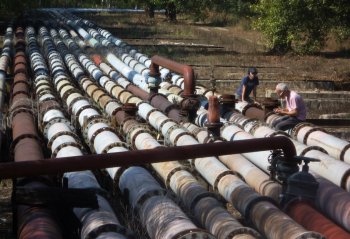For the last 100 years and still today this part of North Bohemia has been the country's main energy hub. Beginning with mineral and metal mining in 15th century and brown coal mining early in the century, the petrochemical industry was introduced during the 2nd world war. Oil brought 100s of kilometers by pipeline is refined here. The effect on the landscape has been dramatic. It is a beautiful area of wooded hills and much remains so today. But around the industries huge changes have taken place; vast opencast pits are excavated to expose and extract the coal, valleys are filled with the soil removed to create hills that did not exist before, many villages and whole towns are demolished or buried to make way for the expanding mines, churches have been picked up and placed eleswhere, brand new lakes are created in the chasms after the coal has been used up.
The whole area is being sculpted around the needs of the energy industry – a process that continues unabated today. However much of the rich history also remains; stunning ancient monastries and castles stand on the edge of the brown coal pits and paths of pilgrimage are rerouted to avoid the encroaching mines. Old villages and the people who live there have no choice but to adapt to the 24/7 drone of machinery. Children grow up with these sights and sounds as their personal legacy. For an outside visitor it can be fascinating, horrific, beautiful and depressing in quick succession.
These recordings were made during two trips in 2012 and 2015.
Peter Cusack is a field recordist and musician with a special interest in environmental sound and acoustic ecology. His projects have included community arts, research into sound and our sense of place, and documentary recordings in areas of special sonic interest (Lake Bajkal, Aral Sea, the Chernobyl exclusion zone, the Caspian oil fields, or UK nuclear sites). The project Sounds From Dangerous Places explores soundscapes at the sites of major environmental damage. Cusack initiated the Favourite Sounds project in London 1998 with the aim of discovering what people find positive about their everyday sound environment. The project has since been established in Beijing, Berlin, Brussels, Chicago, Prague and Birmingham. He is a research fellow in Sound Arts and Design at the London College of Communication and was recently a DAAD artist in residence in Berlin
Tomáš Šenkyřík was born in 1972 at the Přílepy chateau near Zlín. He studied musicology at the Philosophical Faculty of Brno's Masaryk University. In 1997, he founded the Cymbelín ensemble, writing music and performing on the guitar and bass guitar.


